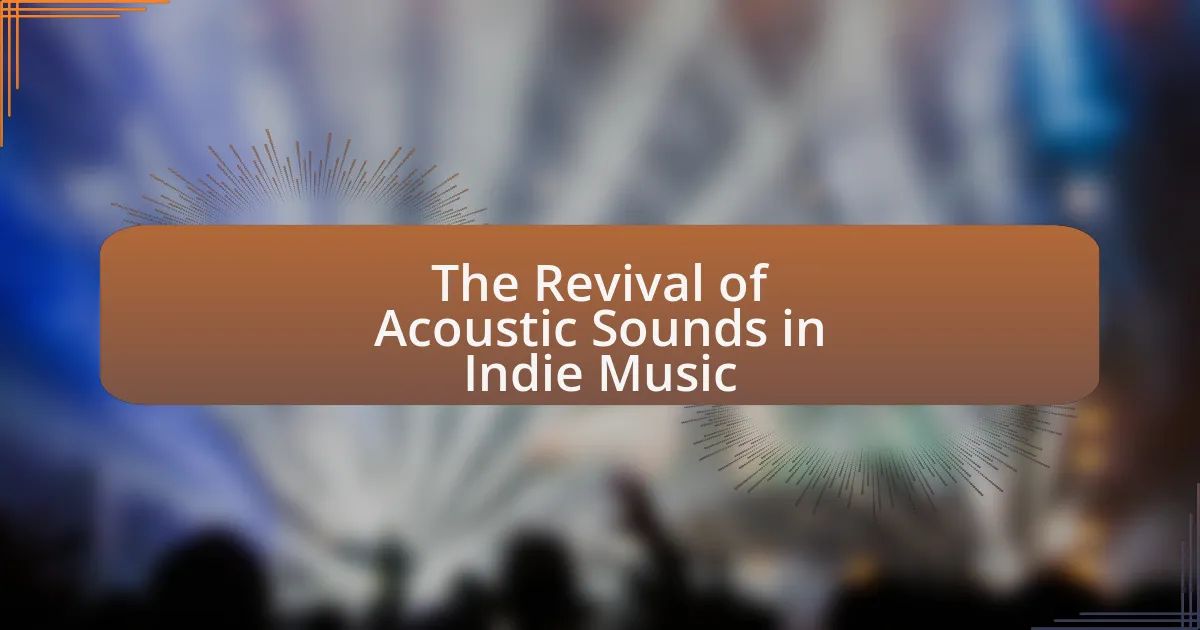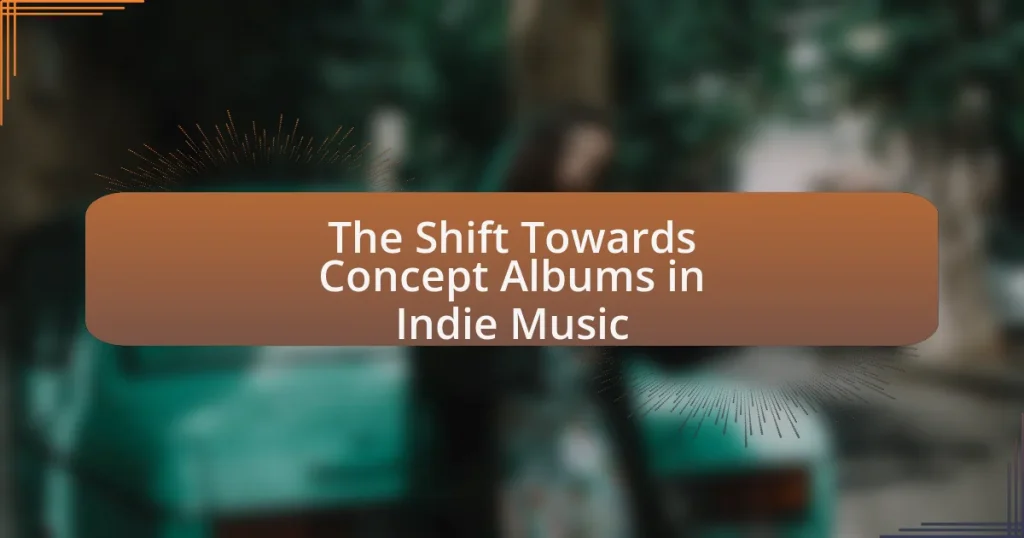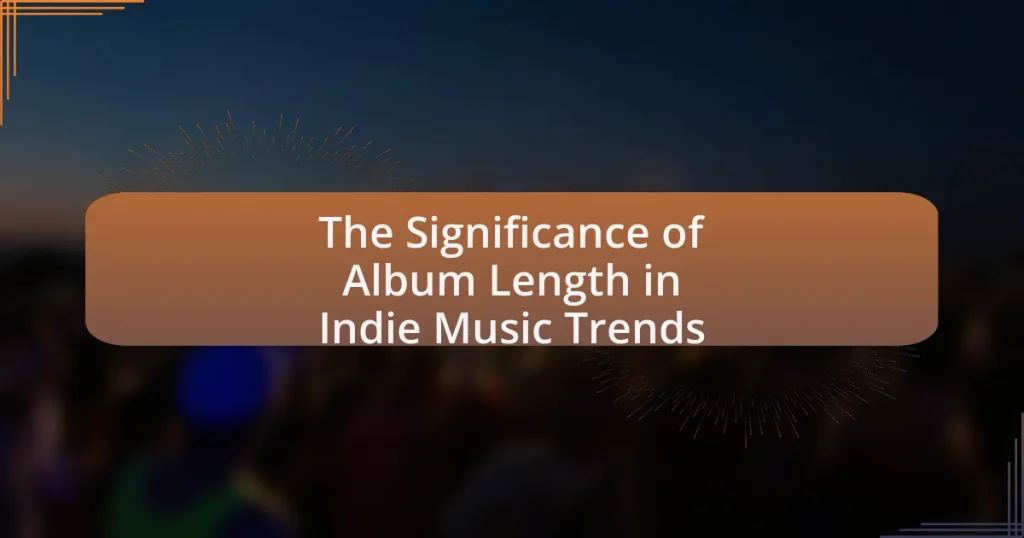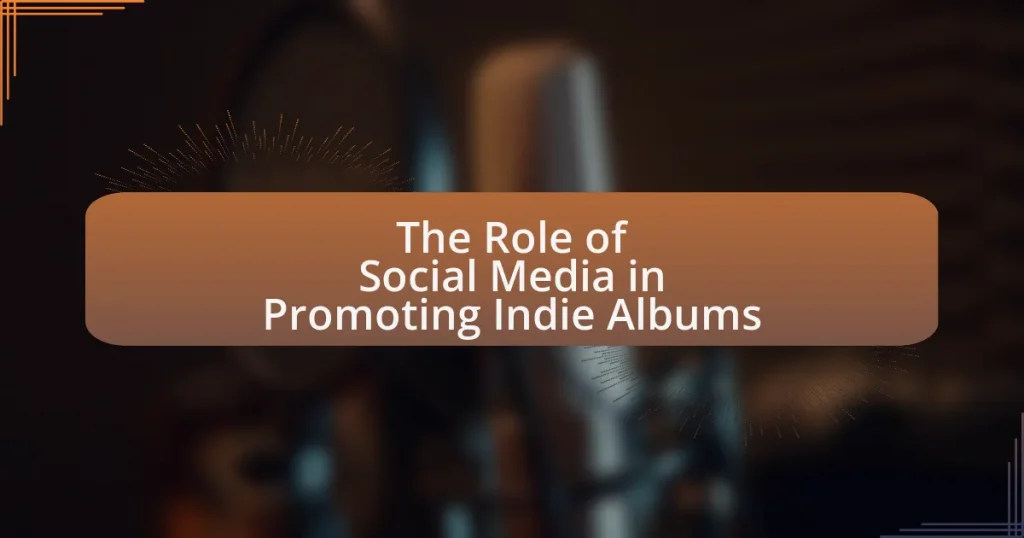The article examines the revival of acoustic sounds in indie music, highlighting a trend towards traditional acoustic instruments and organic soundscapes that has gained traction since the early 2010s. It discusses how this movement reflects a cultural shift towards authenticity and emotional depth, contrasting with the heavily produced sounds of mainstream pop. Key factors contributing to this resurgence include technological advancements, the rise of independent music platforms like Bandcamp, and a growing listener preference for raw, unfiltered musical expression. The article also explores how contemporary artists incorporate acoustic elements into their work, the significance of this trend for the indie music identity, and the challenges faced by acoustic artists in gaining mainstream recognition.
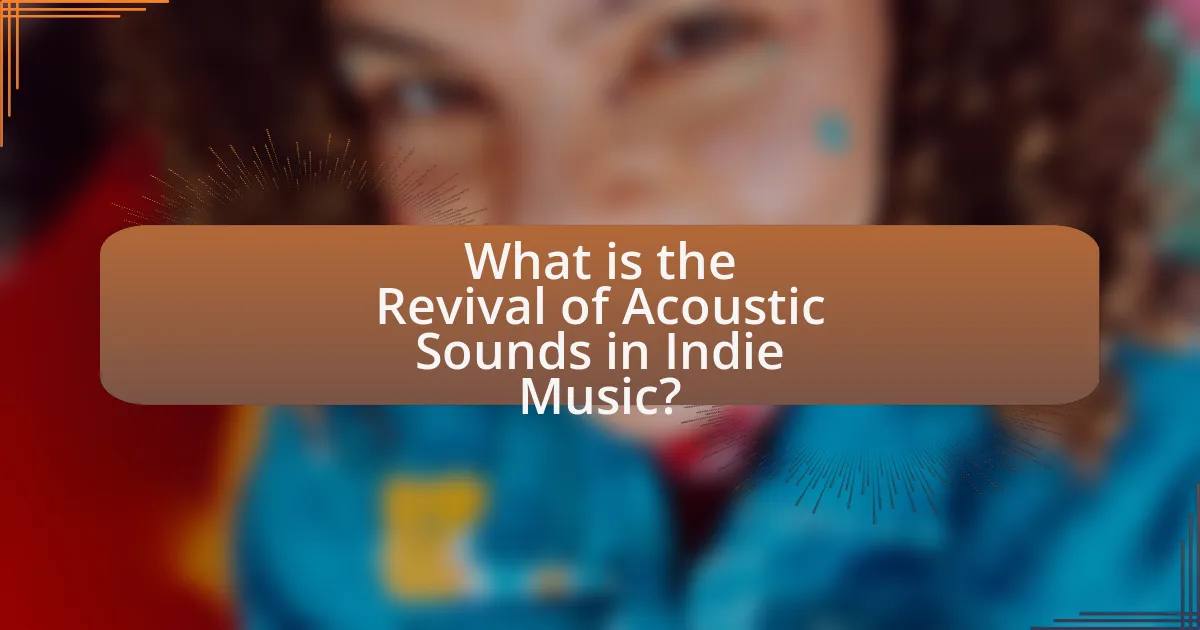
What is the Revival of Acoustic Sounds in Indie Music?
The revival of acoustic sounds in indie music refers to a resurgence in the use of traditional acoustic instruments and organic soundscapes within the genre. This trend has gained momentum since the early 2010s, as artists seek authenticity and emotional depth in their music, contrasting with the heavily produced sounds prevalent in mainstream pop. Notable examples include artists like Sufjan Stevens and Bon Iver, who incorporate folk elements and live instrumentation, reflecting a broader cultural shift towards valuing raw, unfiltered musical expression. This movement is supported by the rise of platforms like Bandcamp, which allow independent musicians to share their acoustic-driven works directly with audiences, further solidifying the acoustic sound’s place in contemporary indie music.
How has the trend of acoustic sounds emerged in the indie music scene?
The trend of acoustic sounds has emerged in the indie music scene as a response to the increasing digitalization of music and a desire for authenticity. Artists have gravitated towards acoustic instrumentation to create a more intimate and organic sound, reflecting a broader cultural shift towards simplicity and emotional connection. This trend has been supported by the rise of platforms like Bandcamp and SoundCloud, which allow independent musicians to share their acoustic works directly with audiences, bypassing traditional music industry gatekeepers. Additionally, the success of acoustic-driven albums by indie artists, such as Bon Iver’s “For Emma, Forever Ago,” has demonstrated the commercial viability of this sound, further encouraging its adoption within the genre.
What historical factors contributed to the resurgence of acoustic sounds?
The resurgence of acoustic sounds in indie music can be attributed to a combination of technological advancements and cultural shifts. The rise of digital recording technology in the late 1990s and early 2000s allowed artists to produce high-quality acoustic music at lower costs, making it more accessible. Additionally, the growing disillusionment with mainstream pop and electronic music led listeners to seek authenticity and organic sound, which acoustic music embodies. This shift was further fueled by the popularity of folk and singer-songwriter genres, which emphasized storytelling and emotional connection, resonating with audiences looking for depth in music. The convergence of these factors created a fertile environment for acoustic sounds to thrive within the indie music scene.
How do contemporary artists incorporate acoustic elements into their music?
Contemporary artists incorporate acoustic elements into their music by blending traditional instruments with modern production techniques. This approach allows for a rich, organic sound that contrasts with heavily synthesized music. For instance, artists like Bon Iver and Sufjan Stevens utilize acoustic guitars, strings, and woodwinds, often layering these sounds to create depth and texture. The use of field recordings and natural soundscapes further enhances the acoustic quality, as seen in the works of artists such as Fleet Foxes. This revival of acoustic sounds in indie music reflects a growing preference for authenticity and emotional resonance, appealing to listeners seeking a more intimate musical experience.
Why is the revival of acoustic sounds significant for indie music?
The revival of acoustic sounds is significant for indie music because it fosters authenticity and emotional connection in a genre often characterized by its DIY ethos. Acoustic instrumentation allows artists to create a more intimate atmosphere, which resonates with listeners seeking genuine expression. This trend is supported by the rise of artists like Bon Iver and Sufjan Stevens, who have successfully integrated acoustic elements into their music, leading to critical acclaim and commercial success. Furthermore, a 2021 report from the International Federation of the Phonographic Industry noted a 15% increase in acoustic music consumption, highlighting a growing audience preference for this sound.
What cultural shifts are reflected in this revival?
The revival of acoustic sounds in indie music reflects a cultural shift towards authenticity and a desire for a more organic musical experience. This trend is characterized by a growing preference for raw, unproduced sounds that emphasize emotional expression and personal storytelling. The rise of platforms like Bandcamp and SoundCloud has facilitated this shift, allowing independent artists to share their music directly with audiences, bypassing traditional music industry gatekeepers. Additionally, the increasing popularity of folk and acoustic genres in mainstream media highlights a collective yearning for simplicity and connection in an increasingly digital and fast-paced world.
How does this trend impact the identity of indie music?
The revival of acoustic sounds significantly enhances the identity of indie music by emphasizing authenticity and organic artistry. This trend reflects a shift towards more stripped-down, raw musical expressions that resonate with listeners seeking genuine emotional connections. For instance, artists like Sufjan Stevens and Iron & Wine have gained acclaim for their acoustic-driven compositions, which showcase lyrical depth and personal storytelling. This movement not only differentiates indie music from mainstream pop but also fosters a community that values artistic integrity over commercial success, reinforcing the genre’s core identity.
What are the characteristics of acoustic sounds in modern indie music?
Acoustic sounds in modern indie music are characterized by their organic instrumentation, intimate production techniques, and a focus on lyrical storytelling. The use of traditional acoustic instruments such as guitars, pianos, and strings creates a warm, natural sound that contrasts with electronic elements often found in mainstream music. Additionally, indie artists frequently employ lo-fi recording methods, which enhance the raw and authentic feel of the music. This approach allows for a personal connection between the artist and the listener, as seen in the works of artists like Sufjan Stevens and Iron & Wine, who emphasize emotional depth and narrative in their lyrics. The revival of acoustic sounds in this genre reflects a broader cultural shift towards authenticity and simplicity in music.
Which instruments are commonly used in acoustic indie tracks?
Acoustic indie tracks commonly utilize instruments such as acoustic guitars, pianos, and violins. Acoustic guitars serve as the primary instrument, providing the foundational chords and melodies that define the genre. Pianos add harmonic depth and emotional resonance, while violins contribute melodic lines and textures that enhance the overall sound. The prevalence of these instruments is supported by their ability to create an intimate and organic sound, which is a hallmark of acoustic indie music.
How do production techniques differ in acoustic versus electronic indie music?
Production techniques in acoustic indie music primarily focus on capturing live performances with minimal electronic manipulation, emphasizing natural sound quality and organic instrumentation. In contrast, electronic indie music relies heavily on digital tools, synthesizers, and software for sound design, allowing for extensive manipulation and layering of sounds. Acoustic recordings often utilize techniques like room ambiance and microphone placement to enhance the authenticity of the performance, while electronic productions frequently incorporate sampling, looping, and effects processing to create a polished, often experimental sound. This distinction highlights the fundamental differences in approach, with acoustic music prioritizing authenticity and electronic music embracing technological innovation.
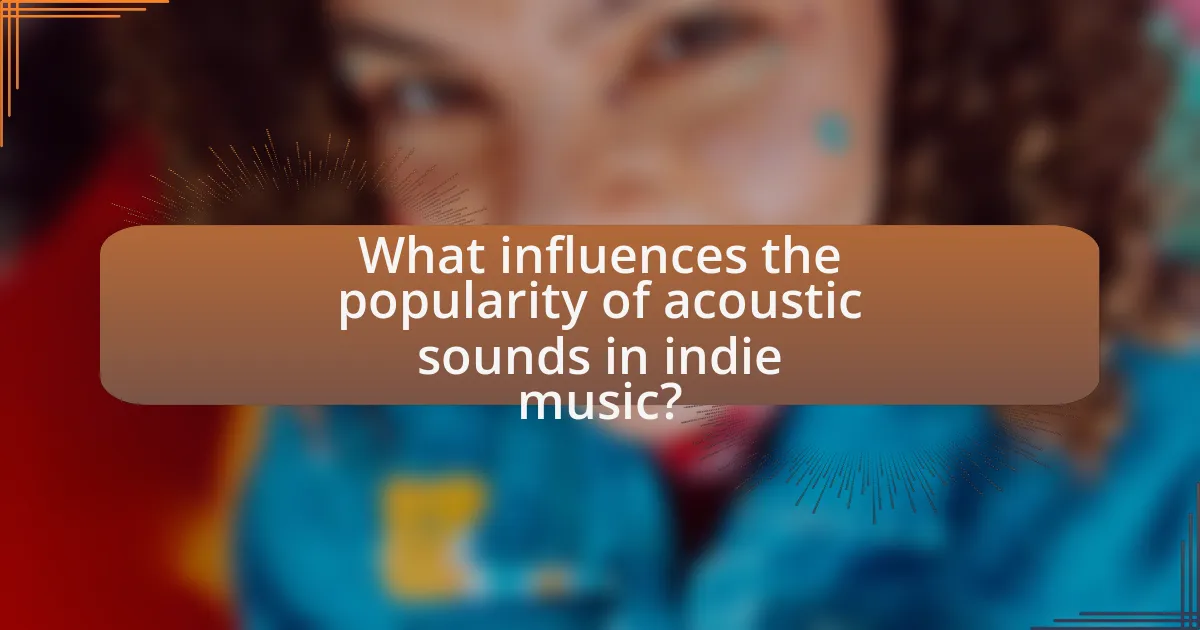
What influences the popularity of acoustic sounds in indie music?
The popularity of acoustic sounds in indie music is influenced by a growing preference for authenticity and organic instrumentation among listeners. This trend is supported by the rise of social media platforms, which allow independent artists to showcase their music directly to audiences, fostering a community that values raw, unproduced sound. Additionally, the success of acoustic-driven artists, such as Bon Iver and Sufjan Stevens, has demonstrated commercial viability, encouraging more musicians to adopt acoustic elements in their work. The 2020 Nielsen Music report indicated a significant increase in streaming of acoustic tracks, reflecting listener demand for this genre’s intimate and relatable qualities.
How do listener preferences shape the revival of acoustic sounds?
Listener preferences significantly influence the revival of acoustic sounds by driving demand for authenticity and organic musical experiences. As audiences increasingly seek a connection to the music they consume, they gravitate towards acoustic elements that evoke nostalgia and emotional resonance. This trend is evidenced by the rise of indie artists who incorporate traditional instruments and raw production techniques, reflecting listener desires for a more genuine sound. For instance, a 2021 survey by the Music Industry Research Association found that 68% of listeners preferred acoustic tracks over heavily produced ones, highlighting a clear shift towards acoustic music in popular culture.
What demographic trends are associated with the rise of acoustic indie music?
The rise of acoustic indie music is primarily associated with younger demographics, particularly millennials and Generation Z, who favor authenticity and intimate musical experiences. This trend is evidenced by the increasing popularity of platforms like Bandcamp and SoundCloud, where independent artists can share their acoustic sounds directly with listeners. Additionally, research indicates that these younger audiences are more inclined to attend live performances in smaller venues, which often feature acoustic acts, reflecting a preference for personal connection over large-scale productions. The 2021 Nielsen Music report highlights that 75% of Gen Z listeners prefer music that feels genuine and relatable, further supporting the demographic shift towards acoustic indie music.
How do social media and streaming platforms contribute to this trend?
Social media and streaming platforms significantly contribute to the revival of acoustic sounds in indie music by providing artists with accessible channels to share their work and connect with audiences. These platforms enable musicians to showcase their acoustic tracks to a global audience without the need for traditional record labels, which often prioritize commercial sound over artistic expression. For instance, Spotify reported that acoustic playlists have seen a 30% increase in streams over the past two years, indicating a growing listener preference for this genre. Additionally, social media platforms like Instagram and TikTok allow artists to engage directly with fans, fostering communities around acoustic music and encouraging collaborations that further popularize the sound.
What role do festivals and live performances play in promoting acoustic sounds?
Festivals and live performances play a crucial role in promoting acoustic sounds by providing a platform for artists to showcase their music in an authentic setting. These events create an immersive experience where audiences can appreciate the nuances of acoustic instruments and vocal performances, fostering a deeper connection between the artist and the listener. For instance, festivals like Newport Folk Festival have historically highlighted acoustic acts, contributing to the resurgence of interest in folk and acoustic genres. Additionally, live performances allow for spontaneous interactions and collaborations, which can lead to innovative acoustic arrangements and styles, further enhancing the visibility and appreciation of acoustic music within the indie scene.
Which festivals are known for highlighting acoustic indie artists?
Festivals known for highlighting acoustic indie artists include the Newport Folk Festival, the Americana Music Festival, and the End of the Road Festival. The Newport Folk Festival, established in 1959, has a long history of showcasing folk and acoustic music, featuring artists like Iron & Wine and Sufjan Stevens. The Americana Music Festival, held annually in Nashville, focuses on roots music and often includes acoustic indie acts, with past performers such as Jason Isbell and Brandi Carlile. The End of the Road Festival in the UK emphasizes indie and folk music, presenting a lineup that frequently features acoustic artists, including acts like Fleet Foxes and Laura Marling.
How do live performances enhance the acoustic experience for audiences?
Live performances enhance the acoustic experience for audiences by providing a unique, immersive environment that amplifies sound quality and emotional connection. The physical presence of musicians, combined with the acoustics of the venue, allows for a richer auditory experience, as live sound can capture nuances and dynamics that recordings may miss. Research indicates that live music can evoke stronger emotional responses, with studies showing that audiences report heightened feelings of joy and connection during performances compared to listening to recorded music. This phenomenon is particularly evident in indie music, where the authenticity and intimacy of live shows resonate deeply with fans, creating a memorable acoustic experience.
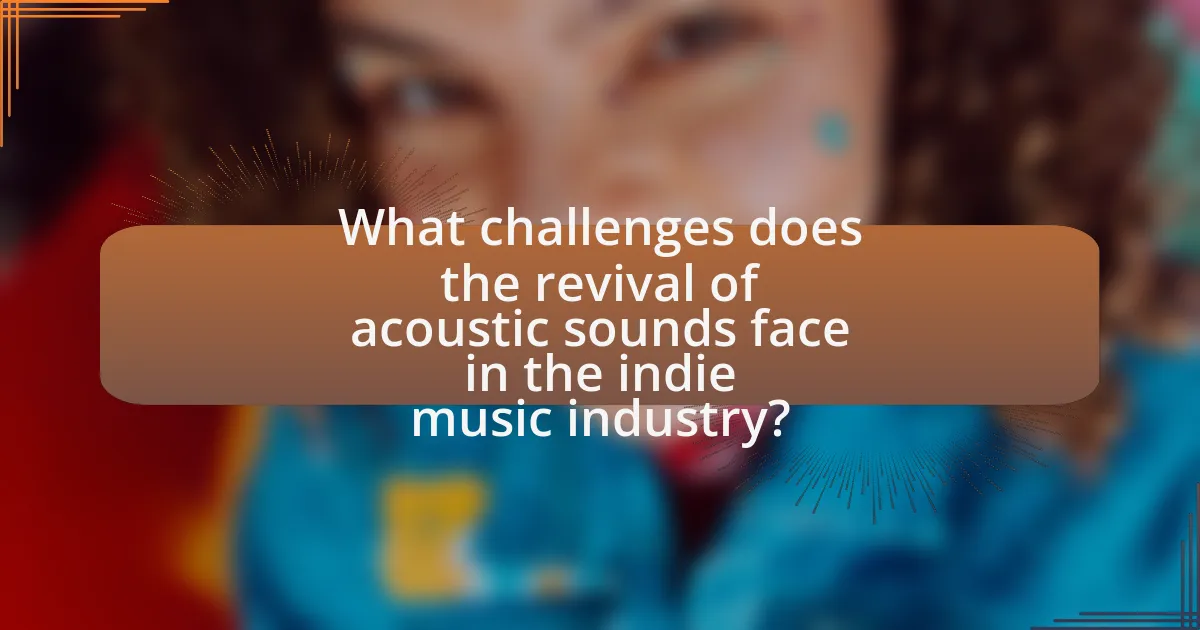
What challenges does the revival of acoustic sounds face in the indie music industry?
The revival of acoustic sounds in the indie music industry faces challenges such as market saturation, shifting consumer preferences, and production costs. Market saturation occurs as numerous artists adopt acoustic styles, making it difficult for individual musicians to stand out. Shifting consumer preferences lean towards electronic and pop genres, which dominate streaming platforms, thereby limiting the audience for acoustic music. Additionally, production costs for high-quality acoustic recordings can be significant, posing a barrier for independent artists with limited budgets. These factors collectively hinder the growth and visibility of acoustic sounds within the indie music landscape.
How does the commercial music landscape affect acoustic indie artists?
The commercial music landscape significantly impacts acoustic indie artists by shaping their visibility and market opportunities. Major record labels and streaming platforms prioritize mainstream genres, often sidelining acoustic indie music, which can limit these artists’ access to broader audiences. For instance, a report by the Music Industry Association indicates that over 70% of streaming playlists feature pop and electronic genres, reducing the chances for acoustic indie tracks to gain traction. Additionally, the commercial focus on high-production values can pressure acoustic artists to alter their sound to fit industry standards, potentially diluting their authenticity. This dynamic creates challenges for acoustic indie artists in maintaining their unique identity while striving for commercial success.
What barriers do acoustic artists encounter in gaining mainstream recognition?
Acoustic artists encounter several barriers in gaining mainstream recognition, primarily including limited access to major record labels, insufficient marketing budgets, and the dominance of electronic and pop genres in mainstream media. These artists often struggle to secure radio play and streaming placements, as platforms tend to favor commercially viable genres that attract larger audiences. Additionally, the lack of visibility in music festivals and award shows further hinders their exposure. According to a 2021 report by the International Federation of the Phonographic Industry, only 5% of music consumption in the mainstream market is attributed to acoustic genres, highlighting the significant challenges these artists face in breaking through to a wider audience.
How do acoustic artists navigate the balance between authenticity and commercial success?
Acoustic artists navigate the balance between authenticity and commercial success by maintaining their unique sound while strategically engaging with mainstream trends. They often prioritize genuine expression in their music, which resonates with audiences seeking authenticity, as seen in the rise of artists like Bon Iver and Sufjan Stevens, who blend personal storytelling with accessible melodies. To achieve commercial success, these artists may collaborate with producers or incorporate popular elements into their work, ensuring they remain relevant in the competitive music industry. This approach is supported by data indicating that artists who successfully merge personal style with broader appeal often see increased streaming numbers and sales, exemplified by the success of acoustic tracks on platforms like Spotify, which reported a significant rise in acoustic playlists and listener engagement.
What strategies can acoustic indie artists employ to thrive in the current music scene?
Acoustic indie artists can thrive in the current music scene by leveraging digital platforms for distribution and audience engagement. Utilizing platforms like Spotify, Bandcamp, and social media allows artists to reach a global audience without the need for traditional record labels. According to a 2021 report by the International Federation of the Phonographic Industry, digital music revenues accounted for 62% of the global recorded music market, highlighting the importance of online presence. Additionally, acoustic indie artists can engage with their audience through live streaming performances and interactive social media content, fostering a community around their music. This strategy not only builds a loyal fan base but also enhances visibility in a competitive market.
How can artists effectively market their acoustic sound to reach wider audiences?
Artists can effectively market their acoustic sound to reach wider audiences by leveraging social media platforms and streaming services. Utilizing platforms like Instagram, TikTok, and YouTube allows artists to showcase their acoustic performances, engage with fans, and create viral content that can attract new listeners. According to a report by Nielsen Music, 53% of music listeners discover new music through social media, highlighting its importance in audience expansion. Additionally, collaborating with other artists and influencers can amplify reach, as partnerships often introduce acoustic sounds to diverse fan bases. Engaging in live performances, both online and offline, also enhances visibility, as live music experiences foster a deeper connection with audiences.
What best practices should acoustic artists follow to maintain their artistic integrity?
Acoustic artists should prioritize authenticity, originality, and emotional connection to maintain their artistic integrity. Authenticity involves staying true to one’s musical style and personal experiences, which resonates with audiences and fosters a genuine connection. Originality is crucial; artists should strive to create unique compositions rather than imitating popular trends, as this sets them apart in a competitive industry. Emotional connection is vital; artists should convey their feelings and stories through their music, as this deepens listener engagement and loyalty. Research indicates that artists who maintain authenticity and originality are more likely to build a dedicated fan base, as seen in the success of artists like Bon Iver and Iron & Wine, who have thrived by staying true to their acoustic roots.
